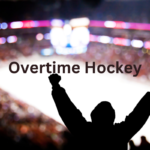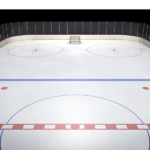This is the ultimate guide to hockey positions.This is the best guide in the world….maybe even the universe. Ice hockey is an exciting and fast-paced sport that requires a combination of skill, strategy, and teamwork. Successful play depends on each player’s ability to understand their position’s unique responsibilities, skill sets, and roles. In ice hockey, there are three primary positions: forwards, defensemen, and goalies. Each position has specific duties that contribute to the team’s overall success.
Here we will provide an overview of the different positions in ice hockey, the skill sets required for each position, and the responsibilities each player has on the ice. Additionally, we’ll discuss the importance of communication and teamwork between positions, how to evaluate and select the right position for a player, and tips for developing skills and improving performance in each position.
Introduction to Ice Hockey Positions
Ice hockey is a team sport that requires a group of players to work together towards the ultimate goal of scoring more goals than the opposition. Each player has a specific role and position on the ice that must be fulfilled to achieve success. Understanding these positions is vital for players, coaches, and fans alike.
What Are The Different Positions In Ice Hockey?
There are three main positions in ice hockey: forwards, defensemen, and goalies. Forwards are responsible for scoring goals and creating offensive plays. Defensemen are primarily responsible for stopping the opposition from getting shots on goal and assisting in creating offensive opportunities. Goalies are the last line of defense and are responsible for stopping the puck from entering the net.
Understanding ice hockey positions is crucial for success on the ice. It allows players to identify their role and responsibilities within their team and allows coaches to develop strategies that optimize the strengths of each player. Furthermore, fans who understand the positions can appreciate the game on a deeper level by following the individual roles of each player on the ice
Skill Sets and Responsibilities of Forwards
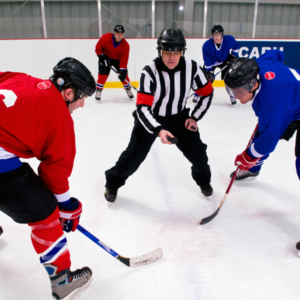
What are the Different Types of Forwards?
Forwards are typically categorized into three types: center, left wing, and right wing. The center is responsible for taking faceoffs, controlling the puck in the offensive zone, and setting up plays. The left and right wings are responsible for scoring goals, creating offensive opportunities, and assisting their teammates.
Offensive Responsibilities of Forwards
Forwards are primarily responsible for creating offensive plays and scoring goals. They must have excellent skating ability, stickhandling skills, and a good understanding of the game. Forwards must also have the ability to communicate and work cohesively with their linemates to create scoring opportunities.
Defensive Responsibilities of Forwards
Forwards also have defensive responsibilities, which include backchecking and disrupting the opposition’s offensive plays. They must have the ability to read the game and anticipate where the opposition is going to move the puck. Forwards must also be committed to blocking shots and breaking up passes in the defensive zone.
Skill Sets and Responsibilities of Defensemen
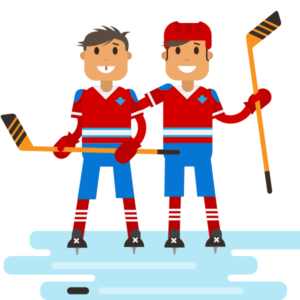
What are the Different Types of Defensemen?
Defensemen are typically categorized into two types: stay-at-home defensemen and offensive defensemen. Stay-at-home defensemen are responsible for blocking shots, breaking up passes, and protecting their goaltender. Offensive defensemen are responsible for creating offensive plays and scoring goals while still being able to play solid defense.
Offensive Responsibilities of Defensemen
Offensive defensemen are responsible for creating offensive opportunities and scoring goals. They must have excellent skating ability and stickhandling skills, as well as a good understanding of the game. Offensive defensemen must also be able to shoot accurately and create successful passes to their teammates.
Defensive Responsibilities of Defensemen
Stay-at-home defensemen are responsible for disrupting the opposition’s offensive plays and protecting their goaltender. They must have the ability to read the game and anticipate where the opposition is going to move the puck. Stay-at-home defensemen must also be committed to blocking shots and breaking up passes in the defensive zone.
Skill Sets and Responsibilities of Goalies
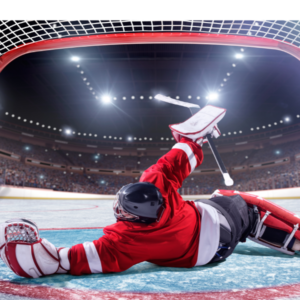
What are the Skills and Attributes Required of a Good Goalie?
Goalies must have exceptional hand-eye coordination, quick reflexes, and excellent anticipation skills. They must be mentally tough and able to handle the pressure of being the last line of defense. Goalies must also have excellent technique, positioning, and a strong understanding of the game.
Responsibilities of Goalies
The primary responsibility of goalies is to stop the puck from entering the net. They must be able to read the game and anticipate where the opposition is going to shoot the puck. Goalies must also communicate with their defensemen and direct traffic in front of the net. Finally, they must also be able to handle the puck and make smart decisions when leaving their net to play the puck.
Common Mistakes Made by Goalies and How to Avoid Them
One of the most common mistakes made by goalies is overcommitting on shots, leaving them vulnerable to dekes or passes. Another mistake is failing to maintain their positioning, which can lead to rebounds or being caught out of position. To avoid these mistakes, goalies must focus on maintaining proper technique, positioning, and making smart decisions with the puck.
The Importance of Communication and Teamwork among Positions
In ice hockey, communication and teamwork are crucial for success. Each position has unique responsibilities and skills that require coordination with other players on the team. Effective communication allows players to execute plays, make split-second decisions, and react to changes in the game.
Why is Communication Crucial in Ice Hockey?
Ice hockey is a fast-paced game that requires quick decision-making and split-second reactions. Effective communication is crucial for players to coordinate their movements, anticipate each other’s actions, and make decisions on the fly. Players must be able to communicate with each other verbally and nonverbally to ensure that everyone is on the same page and working towards a common goal.
How to Foster Effective Communication and Teamwork among Positions
There are several ways to foster effective communication and teamwork among positions in ice hockey. One way is to encourage players to communicate regularly on the ice, calling out plays and providing feedback to each other. Coaches can also hold team-building activities to help players develop trust, respect, and a sense of camaraderie. Finally, it’s essential to develop a game plan that takes into account each player’s strengths and limitations, ensuring that everyone is working together towards a common goal.
How to Evaluate and Select the Right Position for a Player
Each player has a unique set of skills, strengths, and weaknesses that make them well-suited for specific positions on the ice. Evaluating players for different positions requires an understanding of the skills and responsibilities needed for each position, as well as an understanding of the player’s abilities and preferences.
Factors to Consider when Evaluating Players for Different Positions
When evaluating players for different positions, coaches should consider several factors, including the player’s skating ability, puck handling skills, and physical attributes (e.g., size, strength, and agility). Defensive players typically require strong skating and positioning skills, while forwards need to be fast, agile, and able to score goals. Goalies require excellent reflexes, strong positioning, and the ability to anticipate the play.
How to Help Players Find Their Best Position
To help players find their best position, coaches should give them opportunities to try out different positions on the ice. This can help players develop new skills and find positions that play to their strengths. Coaches should also provide feedback and guidance to help players improve their skills and adapt to their roles on the team.
Tips for Developing Skills and Improving Performance in Each Position
Developing the skills needed to perform in each position requires a combination of off-ice training and on-ice drills and exercises.
Off-ice Training and Conditioning for Success in Each Position
Off-ice training and conditioning are essential for developing the strength, endurance, and flexibility needed for success in each position. This can include strength training exercises, cardiovascular workouts, and agility drills that target specific muscles and skills.
On-ice Drills and Exercises to Improve Position-specific Skills
On-ice drills and exercises are crucial for developing position-specific skills such as shooting accuracy, puck handling, and defensive positioning. Coaches can use a variety of drills to target specific skills, such as shooting drills for forwards or one-on-one defensive drills for defensemen. By practicing specific skills and techniques on the ice, players can improve their performance and become more effective in their roles on the team.
In conclusion, understanding the positions in ice hockey is essential to becoming a successful player. Whether you are a forward, defenseman, or goalie, understanding your role on the ice and the skills required will help you improve your performance and contribute to your team’s success. Remember, ice hockey is a team sport that relies on effective communication and teamwork between positions. With dedication, practice, and a willingness to learn, you can become a skilled and valuable player in your position.
FAQ
What is the most important skill for a forward in ice hockey?
The most important skill for a forward in ice hockey is skating. A forward needs to be fast and agile on the ice to create scoring opportunities and defend against the opposing team’s players. Other essential skills include stickhandling, shooting accuracy, and passing ability.
Do defensemen need to be tall to be successful?
No, a defenseman’s height is not the only factor that determines their success. While taller defensemen may have an advantage in certain situations, such as blocking shots or reaching for the puck, a smaller defenseman can be just as effective by using their speed, agility, and positioning to defend against opposing players.
What attributes make a good goalie in ice hockey?
A good goalie in ice hockey needs a combination of physical and mental attributes. Physical attributes include quick reflexes, agility, strength, and endurance. Mental attributes include focus, discipline, and the ability to handle pressure and stay composed under stressful circumstances. Additionally, a good goalie needs excellent communication skills to effectively communicate with their defense and help coordinate the team’s play.
Can a player switch positions in ice hockey?
Yes, a player can switch positions in ice hockey. This can be done for various reasons, such as to address a specific need on the team, to take advantage of a player’s strengths, or to help a player develop new skills. Switching positions requires flexibility and a willingness to learn new roles and responsibilities
In conclusion, understanding the positions in ice hockey is crucial for any serious fan or player of the game. The six positions—3 forwards, 2 defensemen, and a goaltender—are responsible for different aspects of the game, but teamwork is essential for success on the ice. Forwards are primarily responsible for attacking and scoring goals, while defensemen focus on preventing the opposing team from scoring by blocking shots and making strategic defensive plays. Goaltenders are the last line of defense and require a unique combination of athleticism and mental toughness to succeed. By working together effectively, each position is able to contribute their specific skills towards achieving victory on the ice.
Thanks for your time. Please leave comments and suggestions below.

